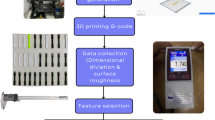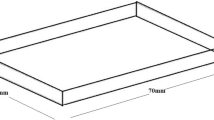Abstract
Machine learning algorithms for classification are employed in this study to generate different models that can predict the surface roughness of parts manufactured from polyvinyl butyral by means of Fused Deposition Modeling (FDM). Five input variables are defined (layer height, print speed, number of perimeters, wall angle, and extruder temperature), and 16 parts are 3D printed, each with three different surfaces (48 surfaces in total). The print values used to print each part were defined by a fractionated orthogonal experimental design. Using a perthometer, the average value of surface roughness, Ra, on each surface was obtained. From these experimental values, 40 models were trained and validated. The model with the best prediction results was the one generated by bagging and Multilayer Perceptron (BMLP), with a Kappa statistic of 0.9143. The input variables with the highest influence on the surface finish are the wall angle and the layer height.






Similar content being viewed by others
Availability of data and material
Experimental data is included in Table 6.
Code availability
All software code is included in Weka release 3.8.
References
Wang C, Tan XP, Tor SB, Lim CS (2020) Machine learning in additive manufacturing: state-of-the-art and perspectives. Addit Manuf 36:101538. https://doi.org/10.1016/j.addma.2020.101538
Razvi S, Feng S, Narayana A, et al (2019) A review of machine learning applications in additive manufacturing. In: Proceedings of the ASME 2019 international design engineering technical conferences and computers and information in engineering conference. Anaheim (CA, USA), pp 1–10
Meng L, McWilliams B, Jarosinski W, Park HY, Jung YG, Lee J, Zhang J (2020) Machine learning in additive manufacturing: a review. Jom 72:2363–2377. https://doi.org/10.1007/s11837-020-04155-y
Ngo TD, Kashani A, Imbalzano G, Nguyen KTQ, Hui D (2018) Additive manufacturing (3D printing): a review of materials, methods, applications and challenges. Compos Part B Eng 143:172–196. https://doi.org/10.1016/j.compositesb.2018.02.012
Moreno R, Carou D, Carazo-Álvarez D, Gupta MK (2020) Statistical models for the mechanical properties of 3D printed external medical aids. Rapid Prototyp J 27:176–186. https://doi.org/10.1108/RPJ-02-2020-0033
Mangat AS, Singh S, Gupta M, Sharma R (2018) Experimental investigations on natural fiber embedded additive manufacturing-based biodegradable structures for biomedical applications. Rapid Prototyp J 24:1221–1234. https://doi.org/10.1108/RPJ-08-2017-0162
Singh S, Singh N, Gupta M, Prakash C, Singh R (2019) Mechanical feasibility of ABS/HIPS-based multi-material structures primed by low-cost polymer printer. Rapid Prototyp J 25:152–161. https://doi.org/10.1108/RPJ-01-2018-0028
Raju M, Gupta MK, Bhanot N, Sharma VS (2019) A hybrid PSO–BFO evolutionary algorithm for optimization of fused deposition modelling process parameters. J Intell Manuf 30:2743–2758. https://doi.org/10.1007/s10845-018-1420-0
Mohamed OA, Masood SH, Bhowmik JL (2015) Optimization of fused deposition modeling process parameters : a review of current research and future prospects. Adv Manuf 3:42–53. https://doi.org/10.1007/s40436-014-0097-7
Jiang J, Hu G, Li X, Xu X, Zheng P, Stringer J (2019) Analysis and prediction of printable bridge length in fused deposition modelling based on back propagation neural network. Virtual Phys Prototyp 14:253–266. https://doi.org/10.1080/17452759.2019.1576010
Mohamed OA, Masood SH, Bhowmik JL (2016) Investigation of dynamic elastic deformation of parts processed by fused deposition modeling additive manufacturing. Adv Prod Eng Manag 11:227–238. https://doi.org/10.14743/apem2016.3.223
Bayraktar Ö, Uzun G, Çakiroğlu R, Guldas A (2017) Experimental study on the 3D-printed plastic parts and predicting the mechanical properties using artificial neural networks. Polym Adv Technol 28:1044–1051. https://doi.org/10.1002/pat.3960
Sood AK, Equbal A, Toppo V, Ohdar RK, Mahapatra SS (2012) An investigation on sliding wear of FDM built parts. CIRP J Manuf Sci Technol 5:48–54. https://doi.org/10.1016/j.cirpj.2011.08.003
Sood AK, Ohdar RK, Mahapatra SS (2012) Experimental investigation and empirical modelling of FDM process for compressive strength improvement. J Adv Res 3:81–90. https://doi.org/10.1016/j.jare.2011.05.001
Li Z, Zhang Z, Shi J, Wu D (2019) Prediction of surface roughness in extrusion-based additive manufacturing with machine learning. Robot Comput Integr Manuf 57:488–495. https://doi.org/10.1016/j.rcim.2019.01.004
Boschetto A, Giordano V, Veniali F (2013) Surface roughness prediction in fused deposition modelling by neural networks. Int J Adv Manuf Technol 67:2727–2742. https://doi.org/10.1007/s00170-012-4687-x
Vahabli E, Rahmati S (2017) Improvement of FDM parts’ surface quality using optimized neural networks—medical case studies. Rapid Prototyp J 23:825–842. https://doi.org/10.1108/RPJ-06-2015-0075
ISO 1302 (1992) Technical drawings—method of indicating surface texture, International Organization for Standardization (ISO), Geneva, Switzerland
Aoyagi K, Wang H, Sudo H, Chiba A (2019) Simple method to construct process maps for additive manufacturing using a support vector machine. Addit Manuf 27:353–362. https://doi.org/10.1016/j.addma.2019.03.013
3d SM (2021) Smart Materials 3D. https://www.smartmaterials3d.com/en/. Accessed 5 Jan 2021
Kuo CC, Chen CM, Chang SX (2017) Polishing mechanism for ABS parts fabricated by additive manufacturing. Int J Adv Manuf Technol 91:1473–1479. https://doi.org/10.1007/s00170-016-9845-0
Montgomery D (2020) Design and analysis of experiments, 10th edn. Wiley, Hoboken
Munirathinam S, Ramadoss B (2016) Predictive models for equipment fault detection in the semiconductor manufacturing process. Int J Eng Technol 8:273–285. https://doi.org/10.7763/ijet.2016.v8.898
Kittidecha C, Yamada K (2018) Application of Kansei engineering and data mining in the Thai ceramic manufacturing. J Ind Eng Int 14:757–766. https://doi.org/10.1007/s40092-018-0253-y
Kerdprasop K, Kerdprasop N (2011) Feature selection and boosting techniques to improve fault detection accuracy in the semiconductor manufacturing process. IMECS 2011 - Int MultiConference Eng Comput Sci 2011 1:398–403
Correa M, Bielza C, Pamies-Teixeira J (2009) Comparison of Bayesian networks and artificial neural networks for quality detection in a machining process. Expert Syst Appl 36:7270–7279. https://doi.org/10.1016/j.eswa.2008.09.024
Barrios JM, Romero PE (2019) Decision tree methods for predicting surface roughness in fused deposition modeling parts. Materials (Basel) 12. https://doi.org/10.3390/ma12162574
Ratner B (2017) Statistical and machine-learning data mining, 3rd edn. CRC Press (Taylor & Francis Group), Boca Raton
Onan A (2015) On the performance of ensemble learning for automated diagnosis of breast cancer. Springer, Cham
Brownlee J (2021) Machine learning mastery with Weka. Ebook. Edition: v. 1.5
Pérez M, Medina-Sánchez G, García-Collado A, Gupta M, Carou D (2018) Surface quality enhancement of fused deposition modeling (FDM) printed samples based on the selection of critical printing parameters. Materials (Basel) 11(8):1–13. https://doi.org/10.3390/ma11081382
Hu H, He K, Zhong T, Hong Y (2019) Fault diagnosis of FDM process based on support vector machine (SVM). Rapid Prototyp J 26:330–348. https://doi.org/10.1108/RPJ-05-2019-0121
Qi X, Chen G, Li Y, Cheng X, Li C (2019) Applying neural-network-based machine learning to additive manufacturing: current applications, challenges, and future perspectives. Engineering 5:721–729. https://doi.org/10.1016/j.eng.2019.04.012
Elhoone H, Zhang T, Anwar M, Desai S (2020) Cyber-based design for additive manufacturing using artificial neural networks for Industry 4.0. Int J Prod Res 58:2841–2861. https://doi.org/10.1080/00207543.2019.1671627
Witten IH, Frank E, Hall MA (2016) Data mining: practical machine learning tools and techniques, 4th edn. Morgan Kaufmann, Burlington
Negnevitsky M (2005) Artificial intelligence: a guide to intelligent systems. Addison-Wesley, Reading
Han J, Kamber M, Pei J (2011) Data mining: concepts and techniques. Morgan Kaufmann Publishers, Inc., San Francisco
John G, Langley P (1995) Estimating continuous distributions in Bayesian classifiers. In: Proc. of the eleventh conference on uncertainty in artificial intelligence. Morgan Kaufmann Publishers, Inc., San Francisco, pp 338–345
Aha DW, Kibler D, Albert M (1991) Instance-based learning algorithms. Mach Learn 6:37–66
Clearly JG, Trigg LE (1995) An instance-based learner using and entropic distance measure. In: Proc. Twelfth International Conference on Machine Learning. Morgan Kaufmann Publishers, Inc., San Francisco, pp 108–114
Quinlan JR (2014) C4.5: programs for machine learning. Morgan Kaufmann Publishers, Inc., San Mateo
Landwehr N, Hall M, Frank E (2005) Logistic model trees. Mach Learn 59:161–205
Breiman L (2001) Random forest. Mach Learn 45:5–32. https://doi.org/10.1023/A:1010933404324
Breiman L (1996) Bagging predictors. Mach Learn 24:123–140
Funding
This work was partially supported by the SMART-EASY project (Reference Number IDI-20191008) funded by the Spanish Centro para el Desarrollo Tecnológico e Industrial (CDTI) and by the Plan Propio de Investigación of the University of Cordoba.
Author information
Authors and Affiliations
Contributions
Conceptualization: [Azahara Cerro]; methodology: [Azahara Cerro and Okan Yiğit]; formal analysis: [Pablo E. Romero]; funding acquisition: [Pablo E. Romero and Andres Bustillo]; investigation: [Azahara Cerro]; resources: [Azahara Cerro and Okan Yiğit]; validation: [Azahara Cerro and Okan Yiğit]; supervision: [Pablo E. Romero and Andres Bustillo]; writing and original draft: [Azahara Cerro and Okan Yiğit]; writing, review and editing: [Pablo E. Romero and Andres Bustillo]. All authors have read and agreed to the submitted version of the manuscript.
Corresponding author
Ethics declarations
Competing interests
The authors declare that they have no competing interests.
Additional information
Publisher’s note
Springer Nature remains neutral with regard to jurisdictional claims in published maps and institutional affiliations.
Rights and permissions
About this article
Cite this article
Cerro, A., Romero, P.E., Yiğit, O. et al. Use of machine learning algorithms for surface roughness prediction of printed parts in polyvinyl butyral via fused deposition modeling. Int J Adv Manuf Technol 115, 2465–2475 (2021). https://doi.org/10.1007/s00170-021-07300-2
Received:
Accepted:
Published:
Issue Date:
DOI: https://doi.org/10.1007/s00170-021-07300-2




